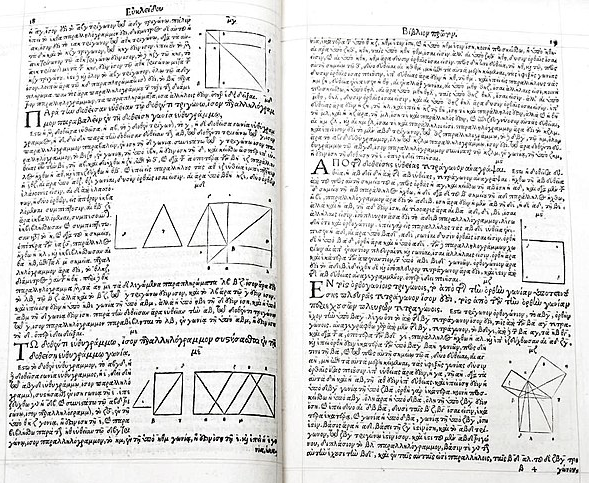Die Elemente
Bildinfo und Lizenz
Bildinfo
- Die Elemente als Nachdruck des griechischen Originals, gedruckt in Basel im Jahr 1533. Euklids Buch diente als Standardlehrwerk der Geometrie bis ins 19te Jahrhundert.
- Originalbeschriftung: : "Eukleidou stoicheiōn bibl[oi] ek tōn Theōnos synousiōn : eis tou autou to prōton, exēgēmatōn Proklou bibl. d." (Greek). (Elementa geometriae). Basel, Johannes Herwegen, 1533. Folio. (323x220 cm). The first printing of the original Greek text of the "Elements", which is edited by the famous Basel-professor of Greek Simon Gryneaus the elder, served as the basis for all later texts and translations of the "Elements" until the nineteenth century. Proclus's seminal commentary to the first book, which had never been printed before, is considered the earliest contribution to the philosophy of mathematics and "one of the most valuable documents in ancient philosophy" (Morrow, p. XXXII). It profoundly influenced Renaissance and modern readings of Euclid's Elements and is responsible for the role that this magnum opus came to play during the Renaissance. It is not until Proclus (ca. 410-485), the great Neoplatonist, applies Plato's manner of thinking to Greek geometry that it achieves completion as a real system. His view of mathematics as part of a larger system of thought was perfectly in tune with the currents of Renaissance thought, and with the commentary of Proclus, the Renaissance student of Euclid was carried beyond the ostensible boundaries of mathematics into the paths of cosmological and metaphysical speculation, paving the way for these fields in modern thought. But Proclus' commentary is not only of seminal importance to the antique and Renaissance interpretation of the work, it also provides us with invaluable information regarding geometers and the history of geometry prior to Euclid. "Its numerous references to the views of Euclid's predecessors, many of them otherwise unknown to us, render it an invaluable source for the history of science." (DSB, pp. 160-61). "These numerous and sometimes very extended references to opinions and accomplishments of his predecessors, taken together with the material rescued from Eudemus's early history of geometry, make Proclus' "Commentary" a priceless source of information regarding the geometry of the previous nine or ten centuries." (Morrow. p. XXVIII). -"Yet the value of the matter it contains regarding the foundations of mathematics and geometry in particular is even greater, though less widely recognized." (Morrow, p. XXXII). Proclus here explains the meaning of "Element" in geometry, he states the theoretical and pedagogical purposes of an elementary treatise, and offers a striking evaluation of the excellence of Euclid's own work. Futhermore, he famously defends pure mathematics, and geometry in particular, against its critics, and includes an important interpretation of the attitude of Plato, who was often used by these critics, against mathematics. Proclus furthermore raises questions that are absolutely fundamental to the understanding of both Plato and the science of Euclid, namely what the nature of the objects of mathematic enquiry is, and what the validity of the procedures used to handling them are. Posing these absolutely fundamental problems for the first time makes Proclus the first real philosopher of mathematics. "Proclus' treatise is the only systematic treatise that has come down to us from antiquity dealing with these questions". (Marrow, p. XXXIII). Proclus' commentary, which takes up the second part of the book, pp. 1-115, is also known as the "Herwagiana", named after the printer. Apart from the above-mentioned elements of the commentary, it also constitutes the first criticism of Euclid to question the "Parallel-axiom", - hereby paving the road to "NON-EUCLIDEAN GEOMETRY". Proclus was the first commentator to be very explicit about his objection to the Parallel axiom, as he refused to count it among the postulates. To justify his opinion he remarks that the converse (the sum of two angles is less than that of two right angles), is one of the theorems proved by Euclid (Book I. Prop. 17), and he thinks it impossible that a theorem, the converse of which can be proved, is not itself capable of proof. He says: "This (postulate) ought even to be struck out of the postulates altogether; for it is a theorem involving many difficulties, which Ptolemy, in a certain book, set himself to solve, and it requires for the demonstration of it a number of definitions as well as theorems, and the converse of it is actually proved by Euclid himself as a theorem." - Proclus' proof, taking up another axiom, was essentially correct, but he substituted one questionable axiom for another. (Se Bonola: Non-Euclidean Geometry). It goes without saying that Euclid's treatise itself, the "Elements" also directly influenced all scientific tho.
- Authors: Euclid, Simon Gryneaus the elder, Johannes Herwegen
Source
- Created: 1533
- Author: Euclid
License
Public Domain: This work is in the public domain in its country of origin and other countries and areas where the copyright term is the author's life plus 70 years or fewer.
- This work is in the public domain in the United States because it was published (or registered with the U.S. Copyright Office) before January 1, 1927.
Warranty
- No guarantee can be given as to the correctness of facts implied or explicitly stated.
- Usage is completey at your own risk. 💣
Originalseite
- Das Bild ist Teil eines online-Lexikons.
- Rhetos Lernlexikon Mathematik, Aachen:
- Siehe unter => Die Elemente => lex
 Die Elemente als Nachdruck des griechischen Originals, gedruckt in Basel im Jahr 1533. Euklids Buch diente als Standardlehrwerk der Geometrie bis ins 19te Jahrhundert.
© Euclid => Zurück zum Artikel
Die Elemente als Nachdruck des griechischen Originals, gedruckt in Basel im Jahr 1533. Euklids Buch diente als Standardlehrwerk der Geometrie bis ins 19te Jahrhundert.
© Euclid => Zurück zum Artikel
